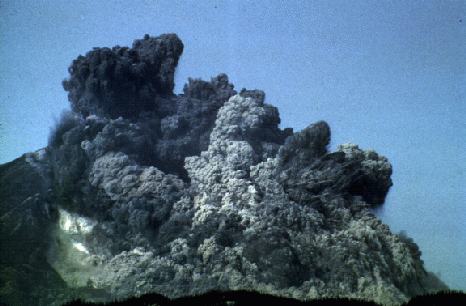Debris Avalanches, Landslides, and Tsunamis

Volcanic structural collapse in the form of avalanches, rock fall, or landslides can be almost any size ranging from a few loose rocks falling from the crater rim of a volcano to large avalanches such as the one at Socompa Volcano in Chile that covers 500 square kilometers (Francis, 1993). Large scale debris avalanches are associated with many volcanic areas including Augustine Volcano in Alaska, Bandai-san in Japan, and Mount St. Helens in Washington. Large scale landslide deposits have been found off the coast of several Hawaiian islands including Molakai and the big island of Hawai'i.
A debris avalanche is formed when an unstable slope collapses and debris is transported away from the slope. Large scale avalanches normally occur on very steep volcanoes. There are two general types of debris avalanches: those that are "cold" and those that are "hot". A cold debris avalanche usually results from a slope becoming unstable whereas a hot debris avalanche is the result of volcanic activity such as volcanic earthquakes or the injection of magma which causes slope instability. For several months before Mount St. Helens erupted in 1980, magma was injected into the north flank of the volcano creating a bulge that was extremely unstable. An earthquake triggered the movement of land in this area and the result was a fast moving debris
avalanche (see image above).
Geological evidence shows that the larger a debris avalanche is, the faster it moves. The reason for this is due to energy stored in material within the avalanche. Some large avalanches have been known to carry blocks as large as three kilometers in length, several kilometers from their source. Such avalanches can travel close to 300 km/hr (Francis, 1993)!
Landslide is a general term for mass movement. It implies a gradual movement rather than the more sudden movement of an avalanche. The perfect example of possible large scale landsliding currently taking place is on the south side of the island of Hawai'i. The dominant feature on this side of the island is Kilauea Volcano. On the south flank of Kilauea there are large fault scarps that are as high as 500 m (1,500 ft). Movement along these fault scarps is causing the south side of Hawai'i to fall into the sea. Studies, using GLORIA side scanning radar and bathymetry maps, on other Hawaiian Islands, such as Molakai, show large areas of landslide deposits covering the sea floor. This indicates that large scale landsliding has occured in the past and may occur in the future (Moore and Normark, 1994).
The hazards that avalanches and landslides can produce are numerous. Both processes can travel large distances and can wipe out everything in their paths. They can dam rivers and lakes and produce flooding. It is also possible that a landslide or avalanche can lead to a decrease in pressure and cause a volcanic explosion. The mixture of debris from a landslide or avalanche with water may produce lahars which can affect people living in valley areas far away from the volcano's summit (Francis, 1993).
Another important hazard that can be produced from avalanches and landslides are tsunamis. Tsunamis are large sea waves that have long wave periods. When these waves reach coastal areas, they can go far inland. If such a wave were produced by the collapse of a large portion of the south side of the island of Hawai'i then it would put people in danger who were living on the coast of Hawai'i and surrounding islands. It could even travel across the Pacific to coastal areas thousands of miles away. Tsunamis aren't always produced by collapsing land masses. They can also be produced by volcanic earthquakes and explosions, atmospheric shock waves due to rapidly moving volcanic material, and lahars or pyroclastic flows that have entered the sea. In 1883, when Krakatau erupted, the main cause of death was due to tsunamis. These great waves reached as high as 35 meters and killed greater than 30,000 people (Scott, 1989).
On the Hawaiian Island, Lanai, a large scale landslide produced a tsunamis that deposited debris 300 m above sea level (Tilling and Lipman, 1993).
Not much can be done to stop avalanches or landslides from occuring. The best way to prevent disaster from happening is to be aware of what has happened in the past and what is happening in the present. Geologists and Geophysicists spend a great deal of time deciphering the geologic past and present. Their efforts can make people aware of the hazards in various areas. As for tsunamis, steps have been taken in the Pacific to establish a warning system. This can be done since tsunamis have a unique wave frequency. For those living in coastal areas that may be affected by tsunamis, it is important to be aware of what a tsunamis is and where to go when such a wave arrives.
Text by C.M. Riley, Photo by Keith Ronnholm (1980)

